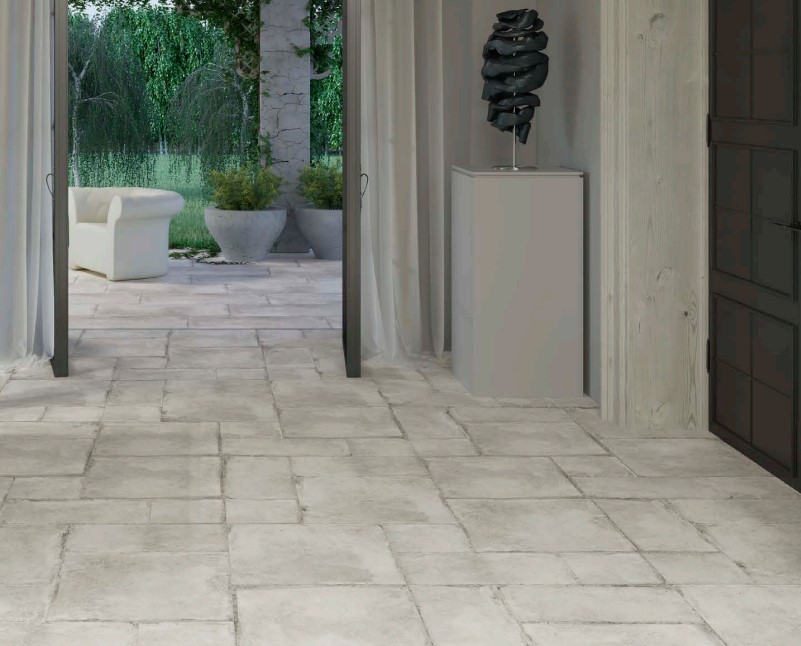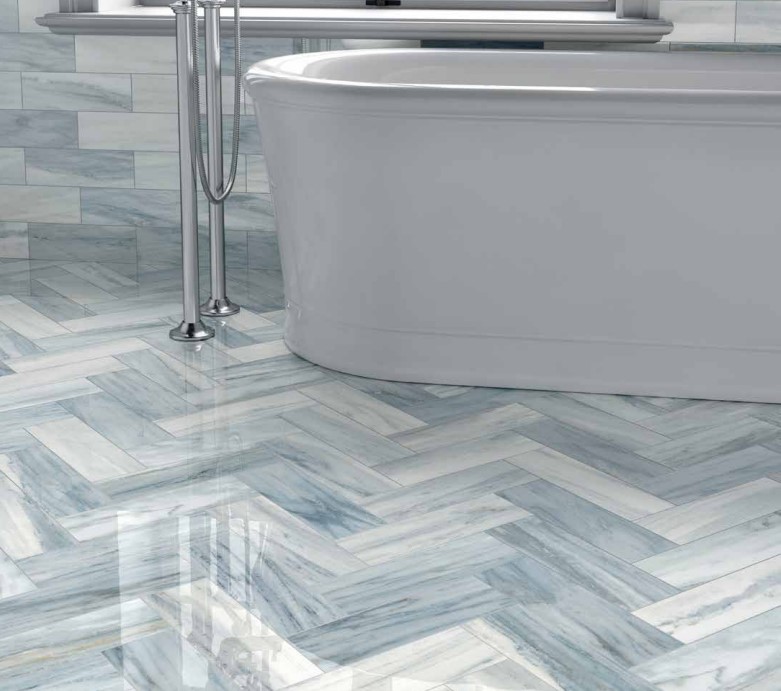Difference Between Rectified and Non-Rectified Tiles
Posted by Mike Belk on Apr 11, 2023

When selecting tiles for your home or commercial space, there are many different options to consider. Two common types of tiles are rectified and non-rectified tiles. Rectified tiles are precisely cut to have clean, sharp edges, while non-rectified tiles have natural, slightly uneven edges. The choice between rectified and non-rectified tiles can impact your space's overall look and functionality, making it important to choose the right type of tile for your specific needs. In this specific article, we will explore the differences between rectified and non-rectified tiles, the pros and cons of each, and how to choose the best option for your project.
Non-Rectified Tiles: Definition of non-rectified tiles:
Non-rectified tiles are porcelain tiles that have not been precisely cut to have sharp, clean edges. Instead, they have natural, slightly uneven edges that give them a more organic look.
How non-rectified tiles are made:
Non-rectified tiles are created by forming clay into tiles and then firing them in a kiln. Depending on the desired finish, the tiles are glazed or left unglazed.

Pros of non-rectified tiles:
Non-rectified tiles have a more natural and rustic appearance, making them a great choice for spaces with a more organic or traditional aesthetic. They also tend to be less expensive than rectified tiles.
Cons of non-rectified tiles:
Non-rectified tiles are less precise than rectified tiles, making installation more challenging. Also, their uneven edges can make grouting more difficult and create an uneven surface.
Best applications for non-rectified tiles:
Non-rectified tiles are best suited for spaces with a more traditional or rustic aesthetic, such as kitchens, bathrooms, and outdoor areas.
Rectified Tiles: Definition of rectified tiles:
Rectified tiles refer to a porcelain tiles that have undergone a precise cutting process, resulting in sharp and clean-cut edges.
How rectified tiles are made:
Rectified tiles are created by cutting larger tiles to precise sizes using a specialized machine. This process creates a tile with clean edges that can be installed with tight grout lines.
Pros of rectified tiles:
Rectified tiles have a precise, clean appearance, making them a great choice for modern or contemporary spaces. Their straight edges make installing and creating a more uniform surface easier.
Cons of rectified tiles:
Rectified tiles are more expensive than non-rectified tiles, and their sharp edges can be more prone to chipping.
E. Best applications for rectified tiles are best suited for modern or contemporary spaces, such as high-end kitchens and bathrooms or commercial spaces like offices and hotels.
Differences between Rectified and Non-Rectified Tiles:
Here is the sharp difference between Rectified and Non-Rectified Tiles. This will help you to choose the best from them by considering all the aspects. Let's have a look;
Appearance:
The main difference between rectified and non-rectified tiles is their appearance. Rectified tiles have clean, precise edges, while non-rectified tiles have more natural, slightly uneven edges.
Size:
Rectified tiles can be cut to very precise sizes, which allows for very tight grout lines and a more uniform surface. Non-rectified tiles have more variation in size and shape, which can create a more organic look.
Installation:
Rectified tiles are easier to install than non-rectified tiles because their precise edges make it easier to create a level surface. Non-rectified tiles can be more challenging to install because of their uneven edges. They cause a little mess during the installation due to their uneven edges and size. Otherwise, they are also good and give a decent look to your home or wherever you want to install them.
Repair and Maintenance:
Rectified tiles are easier to clean and maintain than non-rectified tiles because their clean and clear edges create a more
uniform surface that is easier to keep clean. The tight grout lines between rectified tiles also help to prevent dirt and debris from getting trapped, making them easier to clean. Non-rectified tiles, on the other hand, can have more variation in surface texture and can be more prone to collecting dirt and debris in the uneven edges and grout lines.
Cost:
Rectified tiles are more expensive than non-rectified tiles because of the additional cutting process required to create precise edges. This is where your budget comes in, which gives you a direction on where you want to go. So if you are on a tight budget and want to install tiles in your house or workplace, select the effective tiles that give the look you want. However, the cost difference can vary depending on the specific type and brand of tile.
The durability of Tiles:
Rectified and non-rectified tiles are durable and long-lasting when properly installed and maintained. However, the sharp edges of rectified tiles can be more prone to chipping, which can affect their durability over time.
When choosing between rectified and non-rectified tiles, several important considerations must be remembered. From the overall aesthetic of the space to the level of precision required, here are some key factors to consider when deciding between these two types of tiles.
Considerations Before Choosing the best tiles:
Before choosing between rectified and non-rectified tiles, it's important to consider the space's overall aesthetic. Rectified tiles are known for their sleek, modern appearance, while non-rectified tiles have a more natural, organic look. Think about the design style you're going for and whether a more precise or rustic look would be better suited for the space.
Another important consideration is the level of precision required for the project. If you're working on a project requiring precise measurements and a uniform appearance, rectified tiles may be the better choice. However, if you're working on a project that allows for more tile size and shape variation, non-rectified tiles may be the way to go.
Budget is also a crucial factor to consider when choosing between rectified and non-rectified tiles. Rectified tiles are more expensive due to the additional cutting process required to create precise edges. However, the cost difference can vary depending on the specific type and brand of tile.
Determining the Best Application:
Once you've considered the overall aesthetic of the space and the level of precision required, it's important to determine the best application for the tiles. Consider the area where the tiles will be installed and determine if a more modern, precise look or a more natural, organic look is desired.

For example, rectified tiles may be better for a modern, minimalist bathroom, while non-rectified tiles may be more appropriate for a rustic kitchen backsplash. Think about the overall design style of the space and how the tiles will fit into that aesthetic.
Factors to Keep in Mind When Choosing Between Rectified and Non-Rectified Tiles:
When deciding between rectified and non-rectified tiles, several other important factors must be remembered.
Cost:
As mentioned earlier, the cost is an important consideration when choosing between these two types of tiles. Rectified tiles are generally more expensive than non-rectified tiles due to the additional cutting required to create precise edges.
Durability:
Rectified and non-rectified tiles are durable and long-lasting when properly installed and maintained. However, the sharp edges of rectified tiles can be more prone to chipping, which can affect their durability over time.
Ease of Installation:
While both types of tiles can be installed by a professional, rectified tiles may require more precision and care during installation due to their sharp edges. Non-rectified tiles can be more forgiving in terms of installation, as their uneven edges can be hidden with grout.
Maintenance:
As previously mentioned, rectified tiles are easier to clean and maintain due to their uniform surface and tight grout lines. Non-rectified tiles can be more prone to collecting dirt and debris in their uneven edges and grout lines, making them more difficult to clean.
Overall Design Aesthetic:
Ultimately, the choice between rectified and non-rectified tiles will depend on the overall design aesthetic of the space. If you're going for a sleek, modern look, rectified tiles may be the way to go. However, if you're looking for a more natural, rustic look, then non-rectified tiles may be a better fit.
Conclusions:
In conclusion, rectified and non-rectified tiles have distinct differences that should be considered before making a choice. Rectified tiles have precise edges that create a modern, sleek appearance and are easier to clean and maintain. On the other hand, non-rectified tiles have a natural, rustic look that can vary in size and shape.
When choosing between these two types of tiles, it's important to consider the overall design aesthetic of the space, the level of precision required, and the budget for the project. Factors such as durability, ease of installation, and maintenance should also be considered.
Making an informed decision is crucial when selecting the right type of tile for your project. By carefully considering these factors, you can ensure that your choice will look great and perform well over time.
In summary, whether you opt for rectified or non-rectified tiles, work with a reputable supplier and professional installer to ensure the best possible results. By taking the time to make an informed decision, you'll be able to create a beautiful and functional space that meets your needs and enhances your overall design aesthetic.



